Mastering Knife Sharpening with Whetstone Techniques


Intro
Knife sharpening is an essential skill for anyone who values precision in their culinary or craft work. Using a whetstone, the art of maintaining a blade can transform one’s approach to cutting, slicing, and dicing. The principles of blade maintenance are grounded in both science and technique, which will be the focus of this comprehensive guide.
In this article, we will explore the fundamental aspects of whetstone usage. The steps involved in sharpening a knife might seem simple at first, but a good understanding of the process can yield significant improvement in outcomes. We will cover everything from selecting the right whetstone for a particular knife type, to diagnosing sharpening errors that might be common among novices and even experienced users.
By refining the technique of knife sharpening with a whetstone, you can establish the necessary routines for blade care and maintenance, enhancing both the lifespan of your tools and the efficiency of your tasks. Let’s delve into the nuances of knife sharpening and discover how to avoid common pitfalls.
Prolusion to Knife Sharpening
Knife sharpening is a crucial skill, particularly for those who engage with culinary practices or utilize knives in their daily lives. A well-maintained blade enhances efficiency and ensures precision in cutting, making the understanding of knife sharpening not just relevant but essential. This section aims to establish foundational knowledge about the significance of knife sharpening and its benefits, thereby preparing readers for the deeper aspects of using a whetstone.
Understanding Knife Edges
Knife edges are where the effectiveness of any knife begins. A sharp edge allows for clean cuts, while a dull edge can lead to accidents and frustrations. There are three primary types of edges: straight, serrated, and convex. Each serves its purpose and requires different approaches for maintenance.
- Straight edges are commonly found on chef’s knives. They offer versatility and ease of sharpening.
- Serrated edges appear on bread knives and some utility knives. These edges can be more challenging to sharpen using traditional methods, as they require specialized techniques.
- Convex edges provide a robust cutting surface but require a careful understanding of angles during sharpening.
Recognizing the type of knife you have is vital before delving into sharpening methods. Additionally, the choice of sharpening tool—whether it be a whetstone, sharpening rod, or electric sharpener—also plays a role in maintaining the integrity of the edge.
The Importance of Proper Sharpening
Proper sharpening practices contribute to maintaining the lifespan of a knife. Regular maintenance ensures that the blade remains in optimal condition. Failing to sharpen correctly can lead to several issues:
- Reduced Performance: Dull knives require more force and effort to cut, increasing the likelihood of accidents.
- Increased Damage: Using excessive force on a dull knife may cause damage to the blade or even personal injury.
- Unnecessary Wear: Over-sharpening can erode the blade's material, making future sharpening more complicated.
Ultimately, taking the time to learn proper sharpening techniques can save money and stress over the long term. Ultimately, a sharper knife leads to enhanced performance, making each cutting experience smoother and more enjoyable.
"A dull knife is more dangerous than a sharp knife, as the user must apply more force, increasing the risk of slips and accidents."
This understanding sets the stage for an in-depth look at the whetstone, the main tool we will explore in this guide.
The Whetstone: A Tool Overview
Understanding the whetstone is crucial for anyone interested in knife sharpening. This tool serves as the foundation of effective sharpening techniques. A good whetstone can mean the difference between a blunt blade and one that cuts with precision. Learning about the different types and selecting the right one helps achieve optimal results.
Types of Whetstones
Oil Stones
Oil stones are among the most traditional sharpening tools. They are popular for their durability and effectiveness. A key characteristic of oil stones is the use of oil during sharpening. This lubrication enhances the cutting action and prevents metal filings from clogging the surface.
The primary advantage of oil stones is their longevity. They can serve knife enthusiasts for years with proper care. However, they demand maintenance, like regular cleaning to maintain performance. If not cleaned properly, the efficiency may decrease.
Oil stones can provide an excellent finish on the blade if used correctly, but they require patience and commitment.
Water Stones
Water stones represent a more modern approach to knife sharpening. These stones use water as a lubricant. This method allows for efficient debris removal during the sharpening process. Water stones are well-regarded for their ability to sharpen quickly, making them a go-to choice for many chefs.
A unique feature of water stones is their varying grit options. Users can select from a range of grits for specific sharpening needs. However, they also wear down faster than oil stones, needing replacement or frequent flattening.
Diamond Stones
Diamond stones are known for their exceptional durability. Embedded diamonds in the surface provide an efficient cutting technique. They can sharpen a range of steel types quickly. The primary highlight of diamond stones is their ability to retain their flatness over time, ensuring consistent sharpening performance.
Though diamond stones tend to be more expensive, their long-lasting nature makes them a worthwhile investment for serious users. Some may find they do not provide the same fine finish as water stones, so knowing blade requirements is essential.
Choosing the Right Grit
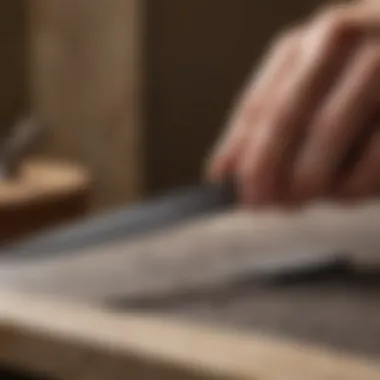
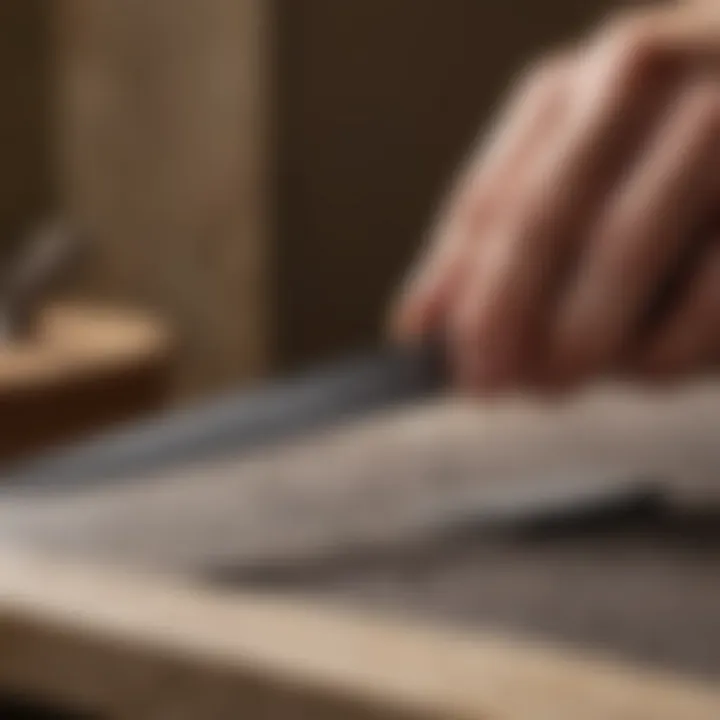
Selecting the appropriate grit plays a key role in achieving desired sharpness. Each grit size serves a specific purpose in the sharpening process.
Coarse Grit
Coarse grit stones are typically used for reshaping or repairing blades. They are ideal when a knife is severely dull. The primary characteristic is their rough texture, allowing for quick material removal. However, care is needed not to overuse coarse grit, as it can damage blades.
Medium Grit
A medium grit offers a balance between sharpening and refining. It is suitable for regular maintenance of knives that show moderate dullness. This grit provides enough bite while offering a smoother edge. Medium grit stones are an excellent choice for everyday users, as they ensure blades remain sharp without excessive wear.
Fine Grit
Fine grit stones are essential for finishing touches and achieving that razor-sharp edge. This type is used after coarse or medium grits for polishing the blade. The key benefit is the level of sharpness it provides. The disadvantage is that it may not be effective for reshaping or repairing blades. Knowing when to switch to fine grit is key for optimal blade sharpness.
Preparing to Sharpen
Preparing to sharpen is a critical phase in the knife sharpening process. Proper groundwork can lead to effective and efficient sharpening and prevent common pitfalls. A well-planned setup not only optimizes the results but also enhances the sharpening experience.
Assessing the Blade
Before diving into the sharpening process, it is essential to assess the blade thoroughly. Checking the knife edge for dullness, chips, or other defects is vital. By understanding the blade's condition, you can determine the necessary approach. This assessment helps identify whether to start with a coarse grit or a finer one. Taking time to examine the blade can save effort and ensure better outcomes. Take note of the blade's material as different steels can require varying techniques.
Setting Up Your Workspace
A tidy and organized workspace is paramount for effective sharpening. A stable and clean environment contributes to precise movements, which are crucial for achieving sharp edges.
Stabilizing the Whetstone
Stabilizing the whetstone is essential to maintain control during the sharpening process. A sturdy base minimizes movement, allowing for more consistent strokes. To effectively stabilize the whetstone, use a non-slip mat or a dedicated whetstone holder. This practice reduces the risk of slippage, ensuring increased accuracy in knife care.
Some whetstones come with rubber bases for improved stability. This key characteristic minimizes distractions, focusing your attention entirely on the sharpening. A properly stabilized whetstone will boost your confidence while sharpening, as it allows for fluid strokes without interruptions.
Choosing the Right Angle
Choosing the correct sharpening angle directly affects the edge's performance. Different knife types have specific angles that yield better results. Typically, kitchen knives are sharpened at a 20-degree angle, while specialty knives may require different settings.
The importance of this aspect lies in its impact on edge retention and overall cutting efficiency. Adopting the appropriate angle enhances the knife's ability to slice through various ingredients. A consistent angle will ensure a sharp, lasting edge. Techniques may vary slightly depending on personal preference, but sticking to established guidelines is beneficial for beginners.
Sharpening Techniques
The sharpening techniques presented in this section are essential to achieving a finely honed blade. Mastering these methods allows both novices and seasoned enthusiasts to maintain knives effectively. Understanding the nuances of each approach provides a pathway to improved sharpness and longevity.
Each technique has its advantages and ideal uses, making it pertinent to choose methods based on the specific knife type and desired outcome. Through the application of proper techniques, one can enhance not only the functionality of the knife but also the safety of its use.
Basic Sharpening Method
The basic sharpening method serves as the foundational skill in knife maintenance. This technique typically involves a deliberate motion along the whetstone at a specified angle. The goal is to remove material from the blade edge until it reaches a sharp, effective point. One must ensure the knife is held steadily, with the blade at a consistent angle against the stone.
The basic method is characterized by its simplicity. New users benefit from its straightforward approach, gaining confidence in sharpening. As users become familiar with this technique, they can experiment with different angles and pressures to refine their skills further.
Advanced Techniques
Advanced techniques take knife sharpening to a higher level. These methods build upon basic sharpening by focusing on angle consistency and pressure management.
Angle Consistency
Angle consistency refers to maintaining a specific angle throughout the sharpening process. This consistency is crucial for achieving a uniform edge on the blade. If the angle varies during sharpening, it can lead to uneven blades, ultimately affecting performance. Angle consistency is a valuable characteristic in sharpening due to its correlation with effective cutting. Precision is critical; a small variance can result in suboptimal sharpness.
Maintaining the correct angle allows for a cleaner edge. It reduces the risk of over-sharpening, which can occur if one applies pressure carelessly. Users who master angle consistency often find that their knives perform significantly better and last longer than those sharpened with less attention to detail.
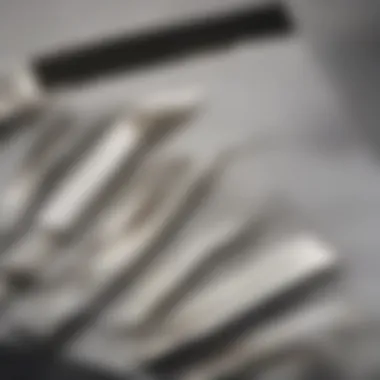
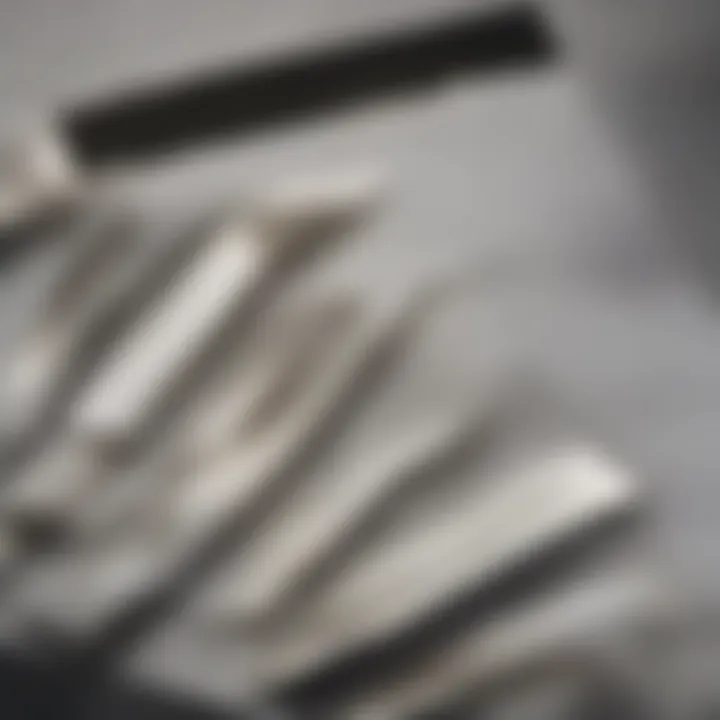
Pressure Management
Pressure management is equally fundamental in sharpening. This aspect involves applying the right amount of force when moving the blade across the whetstone. Proper pressure ensures even material removal without damaging the edge of the knife. When one applies too much pressure, it can cause excessive wear on the blade or the stone itself. Conversely, using too little pressure might result in insufficient sharpening.
The key characteristic of effective pressure management lies in its adaptability. Skilled sharpeners adjust their pressure based on the blade condition. For instance, a dull knife may require more pressure to remove material quickly, while a blade that is closer to being sharp may require a gentler touch to refine the edge.
Post-Sharpening Maintenance
Post-sharpening maintenance is a crucial aspect of knife care that often receives insufficient attention. Once a knife has been sharpened, the steps taken afterwards will greatly influence its longevity and performance. Proper maintenance not only preserves the sharpness achieved through sharpening but also extends the life of the whetstone and the knife itself.
It involves two primary tasks: cleaning the whetstone and properly storing the knife after it has been sharpened. By adhering to these practices, one can avoid unnecessary damage to both tools and ensure their effectiveness during future uses.
Cleaning the Whetstone
After sharpening knives, the whetstone itself requires cleaning. This step is often overlooked, yet it plays a significant role in maintaining the whetstone's performance. Particles of metal and stone residue can accumulate on the surface. This debris hinders the whetstone's ability to sharpen efficiently during the next use.
To clean the whetstone, rinse it under warm water. Gently scrub the surface with a soft brush to remove any debris. This process should ideally be repeated after each sharpening session. Some users prefer to use a dedicated cleaning solution designed for whetstones.
Following washing, it is important to allow the whetstone to air dry completely before storing it. This prevents mold and retains the stone's integrity. A clean and well-maintained whetstone will consistently deliver better results when sharpening.
Storing Your Knife After Sharpening
Storing a knife properly after sharpening ensures it maintains its edge and stays safe when not in use. After the sharpening process, make sure to wipe down the knife with a clean cloth to remove any residue or moisture. Proper drying prevents rusting which can compromise the blade’s quality.
It is best to store the knife in a protective sheath or a knife block. Avoid storing knives loosely in drawers without protection, as this can lead to unintentional damage to the blade and potential injuries. Keeping knives organized not only ensures safety but also prolongs their lifespan.
- Use a knife block for easy access and safety.
- Consider magnetic strips for wall-mounted storage for a sleek display.
- Always ensure that the blade is facing away from any surfaces to reduce risks of accidents.
Remember that knife care is as important as the sharpening process itself. Proper maintenance will maximize the benefits of a sharpened blade.
Common Mistakes in Knife Sharpening
Understanding and avoiding common mistakes in knife sharpening is crucial for achieving the best results. Many individuals, whether novice or experienced, tend to overlook specific errors that can lead to poor knife performance and increased wear. Identifying these missteps helps sharpeners refine their techniques, protecting their investment in quality knives. Furthermore, overcoming these erroneous habits fosters skill development and enhances overall knife care.
Over-sharpening
Over-sharpening is a frequent issue for those who sharpen knives. This happens when the user grinds the blade too much or too often, leading to a loss of metal. Knives are designed with a specific bevel angle to maintain optimal cutting performance. When one continues to sharpen a knife beyond necessity, it can decrease the blade’s lifespan.
- Reason for Over-sharpening:
- Lack of blade assessment.
- Misunderstanding how much sharpening is necessary.
- Desire for immediate sharpness.
This tends to happen especially with high-quality knives, which require less frequent sharpening than cheaper options. It's important to check the knife’s edge regularly and sharpen only when truly needed. Instead of sharpening too often, focus on regular maintenance through honing. This process aligns the edge without removing excess material.
Inconsistent Angles
Holding the knife at varying angles during sharpening is a critical mistake. Consistency in angle is essential for achieving a uniform edge. Variations can lead to uneven sharpening, resulting in poor performance and quicker dulling. Having a stable, predictable angle ensures that the entire edge maintains optimal sharpness.
- Consequences of Inconsistent Angles:
- Difficulty in cutting through food items.
- Uneven wear on the blade edge.
- Increased effort needed when using the knife.
Many users do not realize that even small deviations can significantly affect the outcome. Using a guide or marking the desired angle can help maintain consistency. Practicing in front of a mirror may also assist sharpeners in achieving better angle stability.
"A well-maintained blade is essential for a successful culinary experience. Consistency leads to precision, which enhances the joy of cooking."
Addressing common mistakes in knife sharpening allows every user to achieve better performance from their tools. Fostering awareness of these errors not only increases the usability of knives but also contributes to a more satisfying sharpening experience.
Special Considerations for Different Knife Types
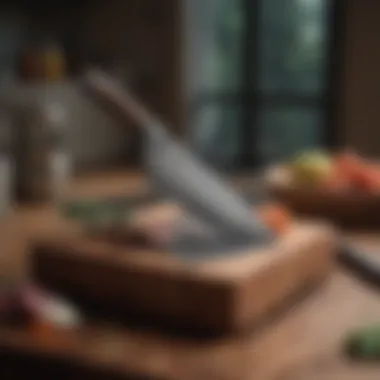
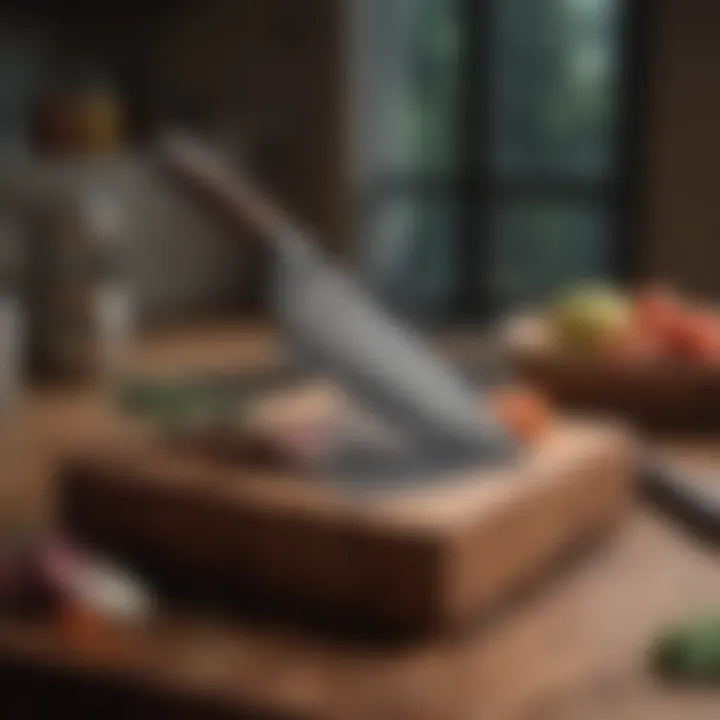
Choosing the right knife for a specific task involves more than just picking one off the shelf. It is vital to understand the unique characteristics of various knife types, especially when it comes to sharpening. Each knife is designed for specific functions, which inherently affects how it should be maintained. This section will detail the special considerations for three common types of knives: Chef knives, Paring knives, and Serrated knives. Proper handling and sharpening techniques for each category ensure optimal performance and longevity.
Chef Knives
Chef knives are the workhorses of the kitchen. Typically ranging from 8 to 10 inches in blade length, they are designed for chopping, slicing, and dicing. One important aspect to consider when sharpening a chef knife is its angle. Most chef knives have a double bevel edge, which means the blade is sharpened on both sides. A common angle for this type of knife is between 15 to 20 degrees.
To sharpen a chef knife effectively, users should maintain consistency in both angle and pressure during the sharpening process. This approach helps develop a sharp edge that can efficiently perform various cutting tasks. Utilizing the right grit on the whetstone for initial sharpening is also critical. For example, a coarse grit (around 1000) can be used for reshaping the edge, while a medium grit (around 3000) is suitable for refining it.
Paring Knives
Paring knives are smaller than chef knives, typically around 3 to 4 inches long. Designed for precision work, they excel in tasks like peeling and trimming. The smaller size and specialized tasks necessitate more careful handling during sharpening. Generally, paring knives feature a more acute edge, usually around 10 to 15 degrees.
When sharpening, it is key to apply a lighter pressure since these knives can easily damage if too much force is used. A finer whetstone (around 4000 to 6000 grit) is often preferred for everyday maintenance. This preserves the edge's acute angle and aids in achieving a sharp, precise edge suitable for intricate tasks.
Serrated Knives
Serrated knives are often overlooked when it comes to sharpening. They serve a specific purpose, well understood by bakers and chefs alike, primarily for slicing bread and other soft products. The serrated edge, characterized by its saw-like teeth, requires different care than straight edges.
Sharpening serrated knives is less about honing the edge and more about maintaining the teeth. A common misunderstanding is that these knives can be sharpened like traditional blades. Instead, the focus should be on maintaining the blade’s basic shape. Specialized tools like serrated knife sharpeners, or using the smooth side of a whetstone, can help maintain the integrity of the serrations.
Furthermore, it is important to note that serrated knives do not require as frequent sharpening as other types. The design allows for pulling through soft surfaces, so users may find they can go longer without needing to sharpen.
"Each knife type deserves dedicated attention during sharpening to ensure peak performance."
Expert Insights on Knife Sharpening
Understanding knife sharpening goes beyond mechanical processes and techniques. It involves incorporating expertise and knowledge from those who have honed their skills over years, like professional chefs and craftsmanship experts. The insights from these individuals are valuable, as they provide practical knowledge that can improve both technique and outcomes. Learning directly from those in the field offers an understanding of real-world applications, nuances, and tips that books and guides may overlook.
By integrating expert advice into the sharpening process, enthusiasts can avoid pitfalls and maximize the performance of their tools. This section emphasizes the significance of these insights for anyone looking to enhance their knife maintenance abilities and achieve precision in their work.
Interviews with Professional Chefs
Interviews with professional chefs shed light on their unique perspectives and approaches to knife sharpening. These culinary professionals rely on their knives daily, making their expertise crucial to understanding how to maintain a superior edge.
- Practical Applications: Chefs often discuss the realities of using knives in a professional kitchen setting. They provide insights into how often a knife should be sharpened, depending on its use. This varies between chefs who specialize in delicate work versus those in high-volume kitchens.
- Personal Techniques: Each chef has their own sharpening routine. Some emphasize the importance of angle consistency, while others may focus on the type of whetstone used. These conversations reveal that no single method fits all. They stress the benefit of adapting techniques based on a chef’s specific knife types and preferences.
- Tools of the Trade: Throughout the interviews, professional chefs recommend specific whetstone brands and grit levels. They address why certain stones work better for particular tasks, providing firsthand accounts of their sharpening journeys.
"A sharp knife is not just a tool; it’s an extension of the chef’s hands. The right sharpening technique defines not only the blade’s performance but also the quality of the food it prepares." - Anonymous Professional Chef
Recommended Practices from Craftsmanship Experts
Craftsmanship experts bring another layer of depth to knife sharpening practices. Their focus is on the art and technique of maintaining knives to ensure optimal performance. Here are some key recommended practices:
- Consistent Maintenance: Regular attention to knife care is crucial. Craftsmanship experts advise against waiting until knives are noticeably dull. Instead, they recommend a routine check-up and light touch-ups.
- Understanding Materials: The choice of whetstone is critical. Experts emphasize that not all stones are created equal. Understanding the specific needs of each knife type can lead to better sharpening outcomes.
- Pressure Control: Mastering the amount of pressure applied during sharpening is a skill in itself. Experts emphasize the importance of applying consistent pressure to maintain the blade’s integrity while achieving a sharp edge.
In summary, the insights gained from interviews with professional chefs and craftsmanship experts serve as a pivotal element in the overall narrative of knife sharpening. These perspectives help illustrate the multifaceted nature of knife care and sharpening, ultimately guiding the reader toward superior techniques and practices.
Concluding Thoughts on Knife Sharpening
Knife sharpening with whetstones is an essential skill that contributes significantly to effective kitchen practices. This final section emphasizes the importance of consistent care and a structured approach for maintaining the quality of one's knives. A careful method not only enhances the blade's performance but also extends its lifespan, necessitating regular engagement with the sharpening process. Properly maintained knives lead to better results, increased safety, and a more enjoyable cooking experience.
The Importance of Regular Maintenance
Regular maintenance of knives, through sharpening with a whetstone, is crucial for optimal performance. A dull blade can lead to accidents as it requires more force to cut. This can result in slips and injuries while working in the kitchen. Sharpening your knife every few months or sooner, if heavily used, ensures that the edge remains effective, allowing for precise cutting and efficient food preparation.
Additionally, routine sharpening promotes the health of the blade. A knife that is constantly used without sharpening can suffer from micro-chips and uneven edges. This degradation not only affects cutting efficiency, but it also accelerates wear on the blade. Thus, investing time in regular maintenance pays off.
Inevitability of Skill Improvement Over Time
As individuals practice knife sharpening, they will undoubtedly observe improvements in their skill set. The process is straightforward but demands patience and attention to detail. Beginners may struggle initially, often finding it challenging to maintain the correct angle or apply the right amount of pressure. However, with consistent practice, these tasks become intuitive.
Each sharpening session serves as an opportunity for learning. As users become more attuned to the feedback from the blade and whetstone, their precision and technique will naturally enhance. Over time, an individual can develop a unique style that complements their knife care practice. Skill improvement is a gradual process that reflects not only greater proficiency in sharpening techniques but also a deeper understanding of the tool itself.
"With every cut, a knifemaker learns. With every stroke on the whetstone, a chef refines a skill."
In summary, knife sharpening is not just about the immediate effects of having a sharp blade. It encapsulates ongoing practices of maintenance and skill development that yield lasting benefits in both culinary and crafting satisfaction.















